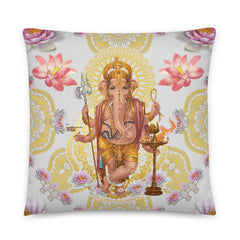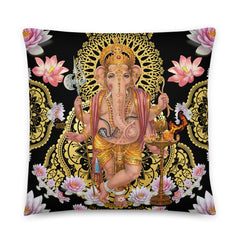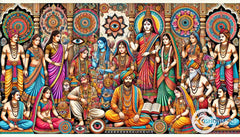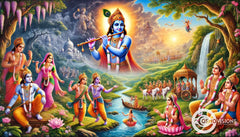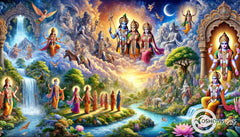Unveiling the Symbolism of Lord Ganesh: Hindu God of Obstacle Removal
Posted by Massimiliano Geraci
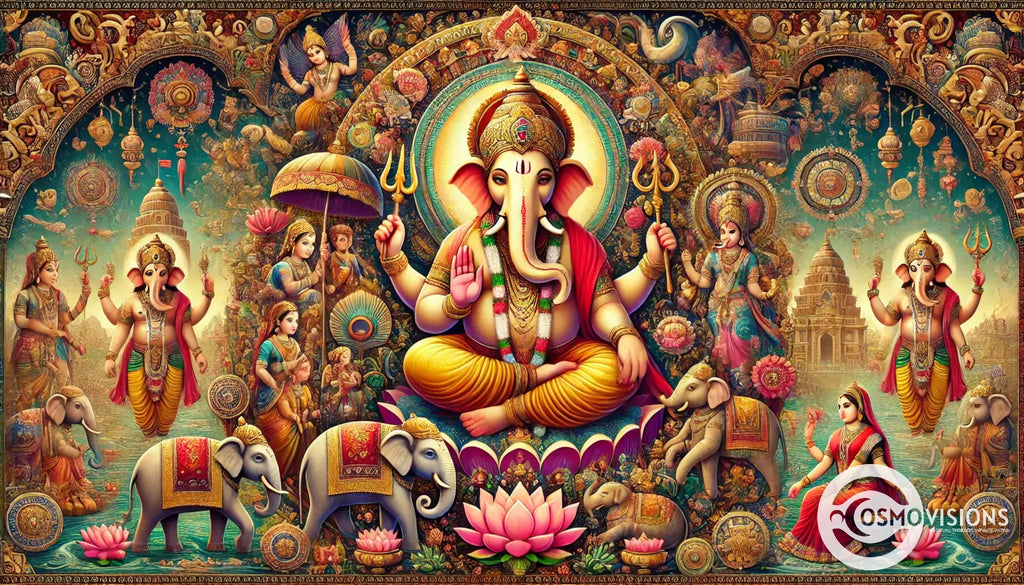
Are you feeling stuck in your path, searching for clarity and direction? Many find themselves at such crossroads, seeking guidance to navigate life's hurdles. In these moments, the symbolism of Lord Ganesh, the Hindu god known for removing obstacles, offers a beacon of hope.
This hindu deity embodies wisdom, the god of protection, and the god of power to pave way through challenges.
Ganesh is not just venerated as an obstacle remover; his large elephant head makes him one of the most recognizable deities across cultures. Our journey today delves into the rich tapestry of Ganesh's symbolism within Hinduism.
We asked ganesha to explore his mythological stories,, attributes, and how he inspires millions around the globe during festivities like Ganesh Chaturthi. By understanding what Ganesha symbolize—new beginnings and assured success in endeavors—we unlock ways to invite positivity into our lives.
Discover inspiration with us.
Who is Ganesh and What Does He Represent in Hinduism?
Moving forward from the introduction, we explore the essence and significance of the hindu god Ganesh. Known as the elephant headed god, Ganesh holds a paramount position among Hindu deities.
He is celebrated as the remover of obstacles and the supreme lord of new beginnings. His presence symbolizes intellect, wisdom, and a barrier against misfortune, guiding devotees toward enlightenment and success in their endeavors.
Ganesh's unique form—an elephant head on a human body—resonates deeply with spiritual symbolism and became the most distinctive of the Hindu gods. The large ears signify listening attentively to understand better; his one tusk represents retaining good fortune while letting go of the unnecessary; and his trunk symbolizes adaptability in different life situations. Ganesha is often depicted holding his own broken tusk, a reminder of the legend where Ganesha broke it off to use as a writing tool for the Mahabharata. His form, often wrapped in vibrant Indian art, stands out in the Hindu pantheon. The laughing moon above his head symbolizes joy and renewal.
As son of supreme god Shiva and Goddess Parvati, he embodies a bridge between earthly existence and spiritual aspiration, making him an instrumental and important deity in rituals across India.
Ganesh—the beacon of knowledge, prosperity, and fortune—guides souls toward overcoming challenges with grace.

Why is Ganesh Known as the Remover of Obstacles?
Ganesh earns the title "Remover of Obstacles" due to his role as a guardian at the door, ensuring smooth paths for devotees and hindering those with ill intentions. Worshipers invoke Ganesh before starting new ventures, praying for obstacles to be destroyed and good fortune to manifest.
His presence in rituals symbolically clears any hurdles in the physical, spiritual, or metaphoric aspects, making him an indispensable figure in Hindu dharma.
During Ganesh Chaturthi, a ten-day festival celebrating his birth and powers, followers bathe statues with rice paste—a symbolic act acknowledging Ganesha's ability to remove barriers.
This celebration draws together millions from around the world, uniting them in acknowledgment of Ganesh's promise to guard their endeavors against challenges. Through these acts of devotion, believers continuously affirm their faith in Ganesh's unique power to ensure success by overcoming obstacles that lay on their paths.
What Does Ganesh's Elephant Head Symbolize?
The elephant head of Ganesh holds profound symbolic significance in Hindu culture, representing intellect, wisdom, and the removal of obstacles. This unique feature underlines his role as a patron of learning and a guide through life's challenges.
The choice of an elephant, revered for its immense strength and sharp memory in Indian tradition, underscores Ganesh's ability to conquer barriers with grace and intelligence. His human head also symbolizes the soul (Atman) while his human body signifies Maya, illustrating the belief in Hinduism that ultimate reality lies beyond the physical world we perceive.
In art and sculpture, Ganesh’s depiction with an elephant head is rich with metaphorical layers, inviting devotees to look beyond the surface to understand deeper truths about existence.
Each aspect of his iconography—from the large ears that teach us to listen more than we speak to the small mouth that advises discretion in speech—encapsulates practical wisdom for overcoming life’s hurdles.
The gentle gaze from his eyes brings comfort, signifying compassion and understanding from the deity worshipped across temples in India while guiding followers toward enlightenment.
Through this symbolism embedded within Hindu texts like Vedas and Puranas, Ganesh, the elephant headed Hindu god emerges not just as a figure of worship but also as a source of guidance on both spiritual journeys and daily endeavors.

How is Ganesh Depicted in Hindu Art and Statues?
In Hindu art and statues, Ganesha, the elephant-faced god, is often depicted with a distinct elephant head, symbolizing wisdom and understanding. Artists carefully carve the image of Ganesha wrapped with a large, round belly below, representing prosperity and the universe's bounty.
Each hand and human body of the deity holds symbolic objects: a 'pasha' (noose) to capture difficulties, an 'ankusha' (elephant goad) to propel mankind on the path of righteousness, a lotus flower as a reminder of enlightenment, and a sweet or 'modak', cherished for its association with satisfaction from spiritual pursuit.
His vehicle, the mouse at his feet, signifies humility and the deity's ability to address even the smallest concerns.
Ganesh’s depictions vary across cultural boundaries but consistently serve as shrines that beckon followers into reflection on life’s obstacles and pursuits. A drum often appears near Ganesh in artworks, echoing rhythmical reminders of time's passage and encouraging devotees towards continuous personal development.
What are the Origins and Myths Surrounding Lord Ganesh?
The birth of Lord Ganesh holds a revered place in Hindu mythology, marked by fascinating tales that intertwine divinity and moral lessons. According to legend, Devi Parvati created Ganesha from turmeric paste she used for her bath, intending him to guard the door while she bathed.
Lord Shiva, unaware of his son's creation, beheaded him in a clash. Distraught by Parvati's grief and anger, Shiva commanded his followers to bring back the head of the first creature they encountered.
They found an elephant and brought its head back.
Shiva placed the elephant’s head on Ganesha’s body, bringing him back to life. This act not only restored Parvati’s joy but also symbolized the integration of man with nature and animals—a central theme in many Hindu teachings about harmony between all living beings.
Hindu god Ganesha thus became known as lord of beginnings and remover of obstacles (Vighnaharta), worshipped first before any major undertaking or business venture.
Transitioning from myths surrounding his origins, exploring how Hindus celebrate Ganesh Chaturthi reveals how these stories continue to influence festivities today.
What is the Story of the Birth of Lord Ganesh?
Parvati, desiring a guard at the door while she bathed, created Ganesha's role, from turmeric paste she applied to her body. She gave life to this figure and instructed him to keep watch. Shiva, returning and finding an unfamiliar boy blocking his way, became enraged and decapitated him.
Distraught by shiva and Parvati's grief, Shiva promised to bring the boy back to life. He sent his gana out with orders to return with the head of the first creature they encountered facing north—a sleeping elephant.
Thus, Ganesh was brought back to life with the head of an elephant.
Ganesh’s birth narrative illustrates profound themes within Hindu mythology: creation from purity (turmeric symbolizing purity), transformation through devotion (the creation of Ganesh by Parvati shows deep maternal love), and renewal or rebirth (Ganesh being revived with an elephant's head).
This story sets the stage for many other legends where Ganesh plays pivotal roles in Hindu epics such as Shaivism tales and in texts like Ganesha Purana and Rigveda, showcasing his significance across various aspects of Hindu culture from guardian at doors to remover of obstacles.
How Did Ganesh Get His Elephant Head?
Moving from the cherished story of Lord Ganesh's birth, we explore another pivotal tale that captures hearts and minds: how Lord Ganesha acquired his distinctive elephant head. This transformative moment in Hindu mythology underscores not just a physical change but a deep spiritual symbolism.
Goddess Parvati, desiring privacy while bathing, created Ganesh from turmeric paste she applied on her body and gave him life with the sole purpose to guard her door. Unbeknownst to Shiva, who returned and was denied entry by Ganesh, conflict arose leading Shiva in anger to decapitate him.
The distress this caused shiva and Parvati prompted Shiva to promise the restoration of their son’s life.
Shiva ordered his followers to bring back the head of the first living creature they encountered facing north - a direction associated with wisdom and auspiciousness in Hindu tradition.
Coincidentally or by divine design, an elephant lay in their path, its head then used to revive Ganesh. This act blessed Ganish with new life as Gajanan - one with the head of an elephant and face signifying intellectual strength, resilience amid obstacles – truly embodying his role as Vighnaharta (remover of obstacles).
Amid lunar cycles ebbing and flowing like human fortunes, Ganesh stands immortalized within Sanskrit verses and Pasha-bearing statues across hindu temples worldwide; His narrative compellingly intertwining divinity with earthly dimensions through artistry that echoes ancient rituals clinging steadfastly over millennia.
What are Some Famous Ganesh Legends from Hindu Epics?
One of the most celebrated tales from Hindu epics about Lord Ganesh involves his creation by Goddess Parvati. She sculpted him from turmeric paste to guard her door while she bathed, unaware that Shiva would be thwarted by this new child when he returned.
Angered by the obstacle, Shiva decapitated Ganesh, leading to a distraught Parvati. To appease her, Shiva promised parvati to restore their son by replacing his head with human body - the first living being found sleeping with its head facing north - an elephant.
Thus, Ganesh received his iconic elephant head and became a symbol of obstacle removal and wisdom.
Another legendary epic recounts how Ganesh became the scribe for the Mahabharata. Sage Vyasa needed a competent scribe who could pen down the epic without pause. Answering this need, Ganesh agreed under one condition - that sage Vyasa must recite the story continuously without faltering.
In turn, Vyasa set a countercondition; Ganesh had to understand each verse before writing it down, ingeniously ensuring pauses for thought. This collaboration between deity and sage led to the creation of one of Hinduism's greatest epics, emphasizing Ganaseh's role as patron of arts and knowledge.

How Do Hindus Celebrate Ganesh Chaturthi?
Hindus celebrate Ganesh Chaturthi with great fervor, marking the birth of Lord Ganesh, the principal deity known for removing obstacles and bringing blessings. Devotees prepare by cleaning their homes and installing clay idols of Ganesh in public pandals or at home.
Rituals kick off with prayers and the chanting of Vedic hymns to invoke his presence. Offerings such as sweets, particularly modaks considered to be Ganesh’s favorite, coconut, and flowers are made to honor him.
The atmosphere buzzes with devotional songs, dances, and sometimes even theatrical performances recounting tales from Lord Ganesh's life.
The celebration culminates in the grand immersion (visarjan) ceremony where devotees procession towards water bodies to immerse the idols, symbolizing a send-off for Ganesh as he returns to Mount Kailasa to join his parents Shiva and Parvati.
This act also represents the cycle of creation and dissolution in nature. Communities come together during this festival not just in India but around the world, showcasing unity and devotion amid vibrant displays of culture.
What Rituals and Offerings are Common During Ganesh Chaturthi?
Ganesh Chaturthi brings joy and festivity across India, inviting devotees to honor Lord Ganesh, the remover of obstacles. This celebration includes a plethora of rituals and offerings that are deeply symbolic and reflective of Hindu spirituality.
1. Installation of Ganesh idols: Devotees bring home or to public pandals carefully crafted idols of Lord Ganesh. The act symbolizes inviting him into their homes and lives for blessings.
2. Pranapratishtha ceremony: Through Vedic culture and mantras, spiritual life is infused into the idol amidst chanting, which marks the presence of Ganesh's energy.
3. Modak offerings: These sweet dumplings are known as Ganesh's favorite treat. Offering 21 modaks is a sign of respect and love towards him.
4. Durva grass: Worshippers offer 21 blades of Durva grass to the deity, symbolizing longevity, prosperity, and fertility.
5. Red flowers: Devotees adorn idols with red flowers; red signifies purity in Hindu culture and brings about positive energy.
6. Pujas (prayers): Conducted twice a day during the festival period, they accompany Vedic hymn recitations to show devotion and seek blessings.
7. Arti ceremony: Evening ceremonies involve lighting lamps, incense, and singing devotional songs, creating an aura of reverence and worship around Lord Ganesh.
8. Immersion (Visarjan): The final ritual involves immersing the idol in water, signifying Lord Ganesh's return to Mount Kailasha to Parvati and Shiva after removing followers' obstacles.
This rich tapestry of rituals underscores the cultural depth and spiritual significance embedded within Ganesh Chaturthi celebrations among Hindu communities. Moving from these vibrant celebrations reveals the deep-seated symbols associated with Lord Ganesh that permeate various aspects of daily life and spiritual practice.
How is Ganesh Chaturthi Celebrated in India and Around the World?
Festivities for Ganesh Chaturthi in India begin with the installation of vibrantly adorned clay models of Ganesh in public pandals and homes. Artisans pour their heart into creating these figures, incorporating themes that often reflect current social and environmental issues, showcasing a blend of reverence and contemporary relevance.
Communities come together to offer prayers, sing devotional songs, and share offerings like sweets - modaks being a favorite as they are considered to be Ganesh's preferred treat. The ritual of Pranapratishtha involves invoking life into the idols through specific chants and hymns, highlighting a moment of collective spiritual awakening.
Around the globe, the celebration adopts local flavors while maintaining its core essence. In countries like the United States, Canada, Mauritius, and parts of Africa where Indian diaspora communities thrive significantly due to migrations dating back several decades for employment or better living conditions; public processions feature fusion music bands alongside traditional dance forms such as Bharatanatyam or Kuchipudi.
These global celebrations foster a sense of unity among Indians abroad and intrigue non-Indians leading to cross-cultural exchanges over shared interests in spirituality and Indic art forms.
This worldwide observance serves as an exemplar on how tradition can transcend geographical borders reinforcing connections among those who identify with Hindu culture at varying degrees across cultures embodying concepts from Muladhara chakra significance to acknowledging Ashtavinayaka importance.
What Symbols and Attributes are Associated with Ganesh?
Ganesh's mouse mount, Vahana, stands out as a symbol of humility and the ability to move through life's smallest cracks with wisdom. This unique pairing embodies the paradox of might and meekness, urging devotees to look beyond the obvious.
The deity holding a Modak in one hand emphasizes Ganesh's role as a patron of arts and sciences, where the sweet represents reward for intellect and wisdom. His four arms not only depict his divine abilities but also signify dharma (duty), artha (prosperity), kama (desire), and moksha (salvation)—core elements guiding human life towards fulfillment.
The moon observed during Ganesh Chaturthi serves as a reminder that even in phases of diminution, completeness is inherent.
A close study reveals that each attribute associated with Ganesh—be it his Pasha for capturing difficulties or Kartikeya reflecting sibling camaraderie—highlights aspects central to understanding life's complex interplay.
Through these symbols, Ganesh invites followers to acknowledge challenges not as impediments but gateways to growth.
What is the Significance of Ganesh’s Mouse Mount?
The mouse mount of Ganesh, known as a symbol in Hinduism, represents the god's ability to control the most elusive and pervasive forms of existence. This small creature, often seen at the feet of Ganesh in various depictions and statues within temples, signifies humility and remembrance.
It serves as a reminder that even the mightiest need support from all forms of life. The mouse is adept at gnawing away at ropes that bind, symbolizing Ganesh’s role as the remover of obstacles who aids his devotees in overcoming challenges big and small.
This unique relationship between deity and mount depicts a harmonious balance between opposite ends of size and power, showing that Ganesh can master even what seems trivial yet is powerful enough to create obstacles or clear paths.
By riding on a mouse, Ganesh delivers a message to his followers: no matter how insurmountable problems may appear, with wisdom (Ganesh) guiding action (the mouse), one can handle life's difficulties.
This symbiosis underscores themes common in Hindu narratives—such as those involving Krishna or teachings similar to those of Buddhist deities and The Buddha—that advocate for unity in diversity and respect for all beings' contributions to our world experience.
Why Does Ganesh Hold a Modak (Sweet) in One Hand?
Moving from the significance of Ganesh's mouse mount, we transition to another distinctive element iconic to Lord Ganesh: the modak. This sweet treat is much more than a confectionery item; it holds profound symbolic importance in depictions of the deity.
Lord Ganesh clasps a modak in one hand, illustrating his love for this sweet, which in Hinduism signifies the reward of joy and contentment for wise decisions and good deeds. The modak serves as a metaphorical reminder that pursuing wisdom leads to the ultimate sweetness of life.
Ganesh's association with the modak also underscores his role as a patron of arts and sciences, encouraging devotees to seek knowledge and enlightenment. Inside every modak's pleated casing lies sweet filling, symbolizing the layers of wisdom hidden beneath outer appearances waiting to be discovered by those devoted to learning.
Thus, offering modaks during rituals like Ganapati Atharvaśīrṣa not only pays homage to Ganesh’s preferences but also celebrates intellectual pursuits and spiritual growth among followers.
What Do Ganesh's Four Arms Represent?
From the sweet modak that represents satisfaction and joy, we move to the profound symbolism of Ganesh's four arms. Each arm holds an object with deep spiritual meaning, guiding devotees on their spiritual path, to wisdom and liberation.
The first hand wields an axe or pasha, symbolizing Ganesh’s ability to sever attachments to worldly desires, freeing souls from the cycle of birth and rebirth. This tool encourages followers to cut ties with materialistic aspirations, pointing them toward a life of simplicity and spiritual purity.
In another, lower left hand, Ganesh cradles a lotus flower, an emblem of enlightenment and the promise of true knowledge amidst the murky waters of material existence. This elegant bloom signifies purity and beauty arising out of difficult conditions, inspiring believers to remain steadfast in their quest for wisdom despite life’s challenges.
Through these symbols - the pasha and the lotus - Ganesh invites humanity into a space where courage meets grace, leading souls towards ultimate liberation from earthly constraints.
Such imagery enriches Hindu temple art and also illuminates paths for seekers within world religions seeking guidance on their spiritual journeys.

Why Do People Pray to Ganesh?
People turn to Ganesh seeking success and safety as they start new ventures. Known widely as the remover of obstacles, his blessings are invoked at the beginning of prayers, important tasks, and religious ceremonies.
Ganesh's guidance is believed to clear paths that may be blocked by challenges or hurdles. As a deity who embodies wisdom, believers also pray to him for insight and understanding.
Ganesh holds a revered position in the arts and sciences, acting as a patron for intellectuals and creatives. This special association encourages followers to seek his favor when pursuing knowledge or artistic endeavors.
His presence symbolizes an encouragement for learning and creativity among his devotees, making him an integral figure in both spiritual and academic communities.
What Aspects of Life is Ganesh Invoked For?
Ganesh is called upon by devotees for success in various life endeavors. His role as the remover of obstacles makes him especially significant at the start of ventures, such as new businesses or educational pursuits.
Devotees pray to Ganesh for luck, prosperity, and protection against challenges. This deity's unique power to remove hurdles also sees him invoked during religious ceremonies and cultural festivals to ensure smooth proceedings.
Moreover, Ganesh plays a pivotal part as a patron of arts and sciences. Scholars and artists seek his blessings to fuel creativity, wisdom, and technical skill in their work. Ganesh’s guidance is sought after for its ability to inspire innovation within these fields.
His influence spans beyond mere obstacle removal into areas that foster intellectual growth and artistic expression.
How is Ganesh a Patron of Arts and Sciences?
Ganesh holds a unique place as a patron of the arts and sciences, guiding the hands and minds of creators and thinkers. His association with wisdom and intellect positions him as an ideal deity for those engaging in academic pursuits or creative endeavors.
Poets, artists, and scientists alike invoke his blessings to remove obstacles from their path, ensuring success in their works. Ganesh’s role extends beyond mere inspiration; he embodies the essence of innovation and mastery over one's craft.
This deity’s influence stretches across various domains, including literature where Ganesh is often invoked at the start of new writing projects to ensure smooth progress. As scholars delve into complex theories or artists initiate creating profound pieces, they seek Ganesh's guidance to foster clarity of thought and creativity.
This makes him not just a figure of devotion but also a fundamental force in the progression of arts and sciences throughout history.
Continuing this exploration leads us naturally to understanding what symbols and attributes are associated with Ganesh.
What Can We Learn from the Teachings and Symbolism of Ganesh?
The teachings and symbolism of Ganesh offer profound lessons on resilience, wisdom, and the removal of obstacles in our lives. His head of an elephant, head, a symbol of immense wisdom and understanding, encourages us to look beyond appearances to discern the deeper truths of existence.
Ganesh teaches us that every challenge we face is an opportunity for growth and learning. He embodies the concept of new beginnings, reminding us that with faith and determination, we can overcome any hurdle.
The mouse mount of Ganesh also signifies humility and the importance of controlling one's ego amid success.
Ganesh is also widely revered as a patron of arts and sciences, illustrating the value of intellect and creativity in overcoming difficulties. Holding a modak (sweet) in one hand symbolizes the reward of joy following perseverance through challenges.
Through his four arms, he demonstrates that multi-faceted approaches often lead to comprehensive solutions. These attributes guide admirers to embrace change with grace while striving for knowledge and enlightenment.
Such insights enrich spiritual practices and provide practical guidance for personal development across various aspects of life including professional endeavors, relationships, and inner peace.
What Life Lessons Does Ganesh Teach Us?
Ganesh imparts the wisdom of overcoming obstacles not with force but with intelligence. He teaches that perseverance combined with wisdom lights the path to success. His association with Pasha, a symbol of bondage and liberation, educates us on the importance of self-restraint and discipline in achieving our goals.
It's a lesson in understanding our limitations and using them as stepping stones rather than seeing them as insurmountable barriers.
His story also underscores the significance of respect for all beings, regardless of size or strength. The mouse mount, often seen at Ganesh's feet, illustrates that even the smallest creature can carry immense responsibility if it has determination and courage.
Through this partnership, we learn about humility and service to others—a core aspect ingrained within many spiritual practices around the globe including Heramba tradition. As we delve deeper into these teachings, let's explore how Ganesh embodies the concept of new beginnings.
How Does Ganesh Embody the Concept of New Beginnings?
Lord Ganesh stands at the threshold of new ventures and beginnings, symbolizing the removal of obstacles for fresh endeavors. As devotees start new journeys, they often seek his blessings to clear the path ahead, making him an integral figure in rites of passage and inaugural events.
His presence is believed to ensure success by laying a foundation free from hindrances, embodying hope and renewal. Thus, Ganesh represents not just physical or material removal of barriers but also spiritual cleansing, preparing one's soul for the adventures that lie ahead.
Symbols associated with Ganesh further illustrate this concept; his mouse mount signifies humility and the ability to overcome challenges no matter their size. With every modak (sweet) in hand promising reward for wisdom and perseverance, he encourages believers to pursue their goals with dedication.
This divine support invites individuals to start anew with confidence and faith in their protector's guidance. Such traditions underscore why Ganesh remains a beloved deity among followers seeking good fortune and auspicious beginnings.
Why is Ganesh a Beloved Deity in Hindu Culture?
Ganesh secures his place as a beloved deity in Hindu culture through his role as the remover of obstacles, embodying wisdom, intelligence, and prosperity. His unique form with an elephant head symbolizes power and the ability to overcome any challenge.
Devotees turn to Ganesh at the beginning of ventures to ensure smooth paths devoid of hurdles. This practice spans centuries and remains vibrant across different regions, reflecting his universal appeal among followers.
His association with auspicious beginnings makes him a pivotal figure during festivals like Ganesh Chaturthi, where communities unite to celebrate his birth and blessings. The rituals, marked by offerings of modaks (sweets) considered to be Ganesh’s favorite food, and intricate statues that are later immersed in water bodies, showcase profound devotion.
These celebrations honor Ganesh and serve as cultural events that knit social fabrics together around shared beliefs in resilience and new starts.






















